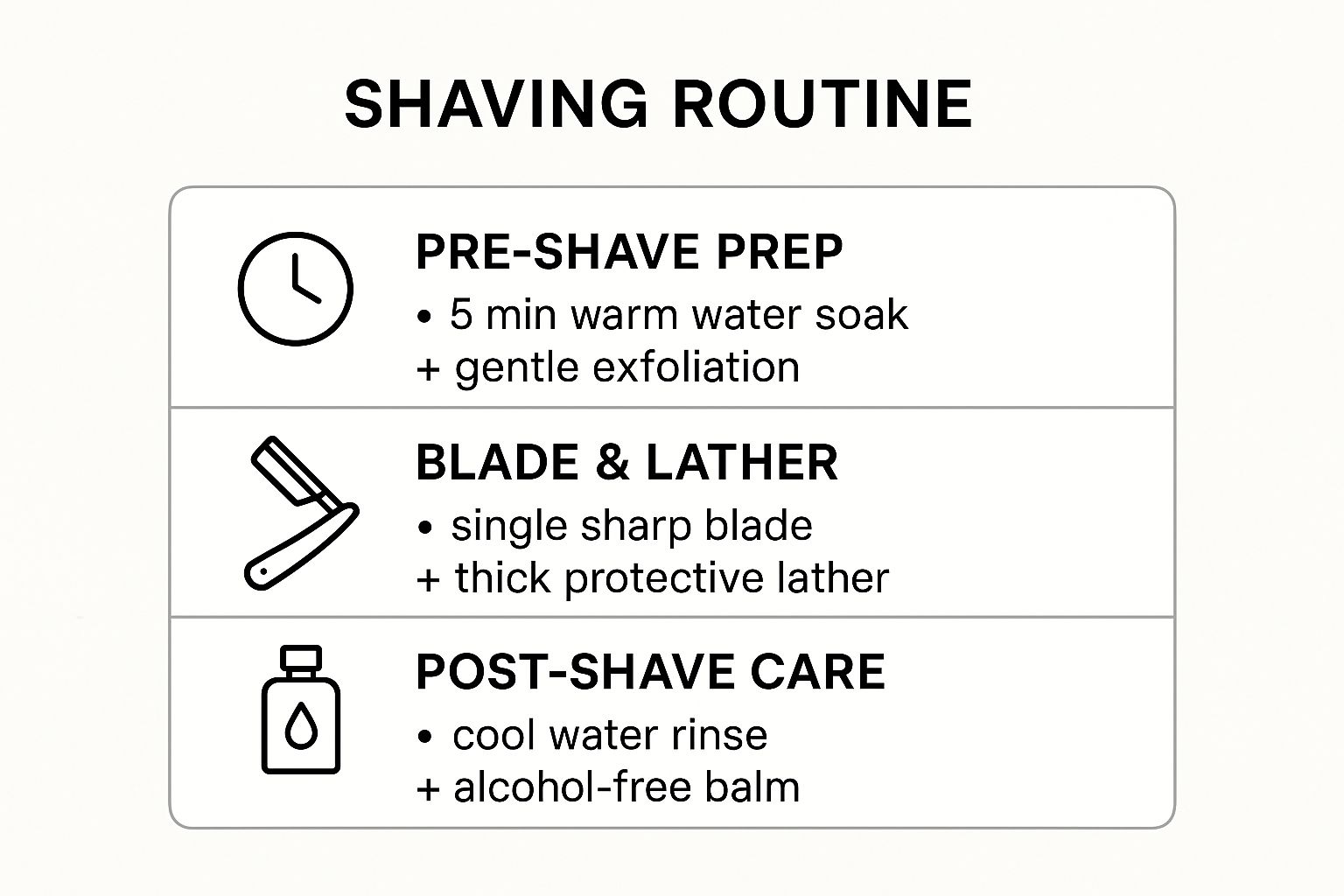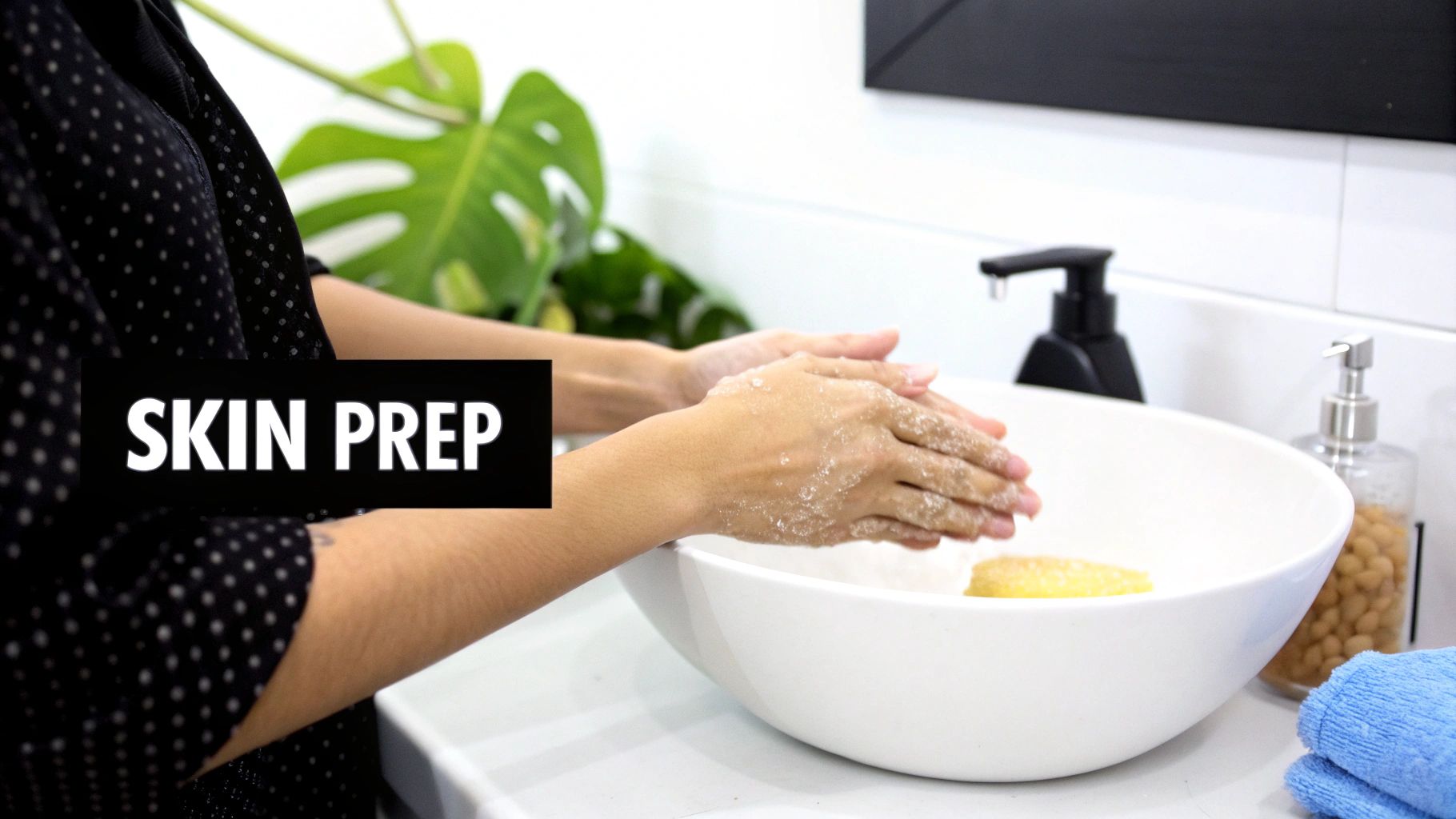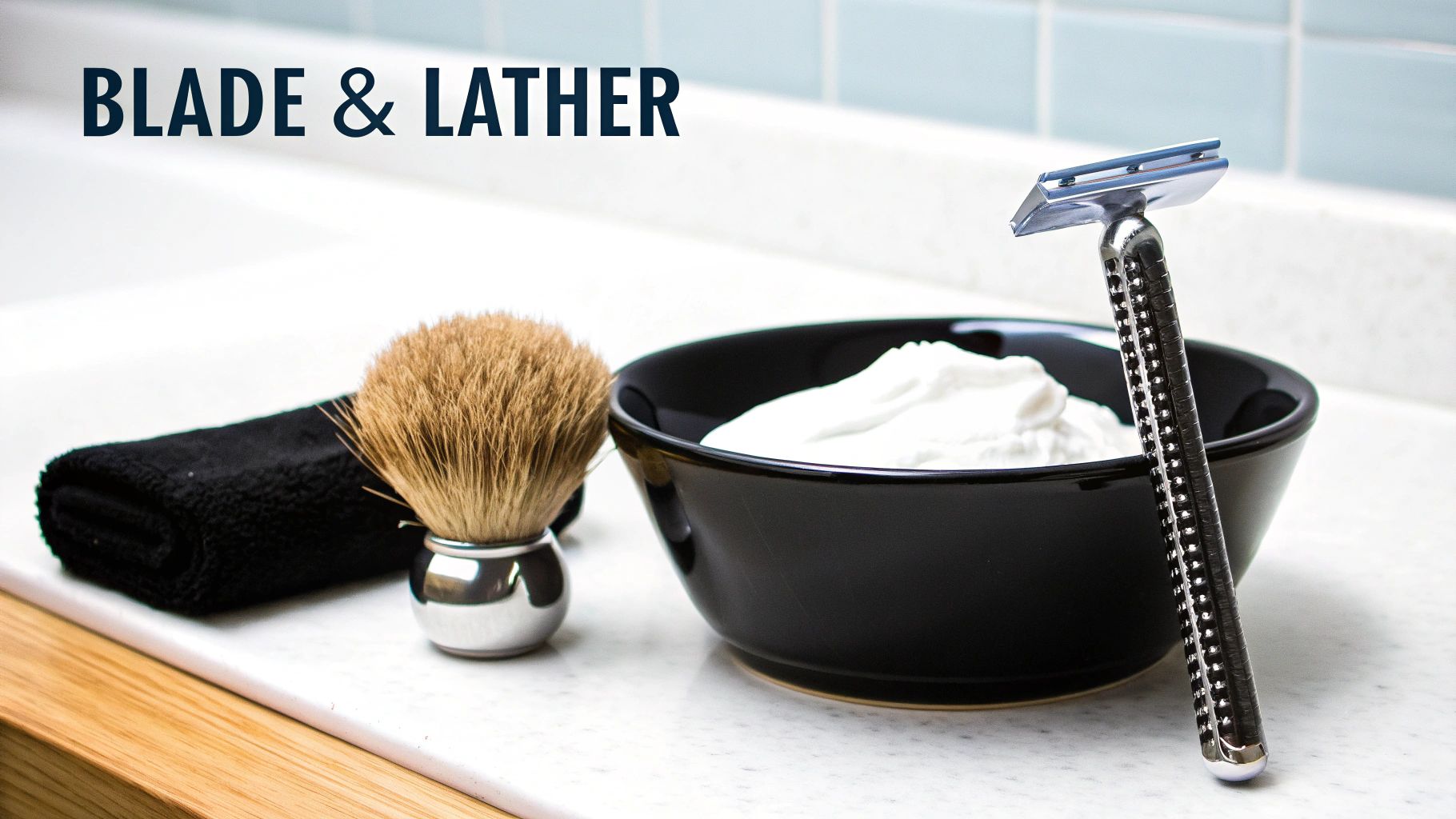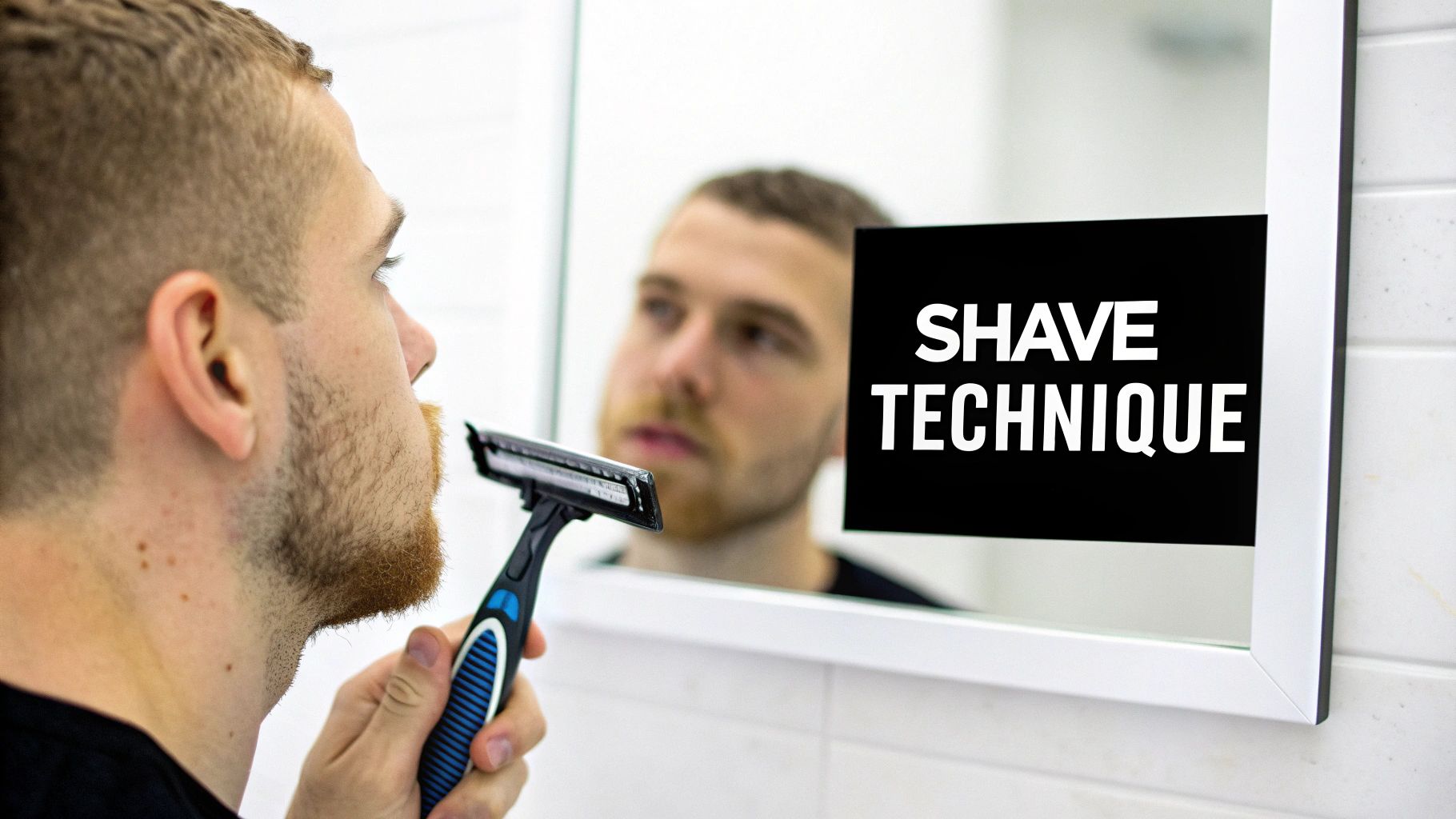Jan Elvis
20.10.2025

Jan Elvis
20.10.2025
If you want to know how to shave without irritation, it really comes down to a simple, four-part system: proper preparation, the right tools, a gentle technique, and consistent aftercare. It’s that simple. Most of the time, razor burn, bumps, and redness happen because one of these steps got skipped. Once you nail this system, you’ll get a smooth, comfortable shave every single time.
Forget about finding one miracle product that solves everything. A consistently great shave isn’t about what you buy; it's about your process. It’s a skill, and it’s built on a few fundamentals that work together to protect your skin from the blade.
So many guys focus only on the moment the razor is on their face, but what you do before and after is just as critical. Those pre- and post-shave steps are your best defense against common headaches like razor burn and ingrown hairs.
This approach turns shaving from a rushed chore into a thoughtful grooming ritual. You can see this shift happening everywhere—the global shaving market was valued at USD 36.46 billion in 2024. That number shows just how many people are looking for a better way to do it. You can dig into the specifics in the full market research.
This infographic lays out the essentials perfectly.

As you can see, every stage has its job to do, from getting your skin ready to helping it recover afterward.
The whole thing can be broken down into a few key areas. If you just focus on getting these right, you'll see a massive improvement.
To help you remember these critical steps, here's a quick summary table. Think of it as your cheat sheet for a perfect shave.
| Stage | Primary Goal | Key Actions |
|---|---|---|
| Preparation | Soften Skin & Hair | Warm water, pre-shave oil, gentle exfoliation. |
| Lathering | Create a Protective Barrier | Use a quality cream/soap, build a thick lather. |
| Shaving | Cut Hair Cleanly & Gently | Use a sharp blade, light pressure, shave with the grain. |
| Aftercare | Soothe & Hydrate Skin | Rinse with cool water, apply an alcohol-free balm. |
Mastering these stages turns your routine into one that actively supports your skin's health, rather than just stripping it. For even more ways to level up your entire routine, take a look at our other grooming tips for men.

Here's a secret that professional barbers know: most shaving irritation has almost nothing to do with the blade. It’s all about the prep work. A truly great shave begins with warm, soft skin and pliable hair, which is exactly why barbers start with those iconic hot towels.
You can easily get that same professional-grade effect at home. The best time to shave is right after a hot shower. All that steam and heat opens your pores and softens up even the coarsest whiskers, making them much easier for a blade to slice through.
No time for a full shower? Just soak a washcloth in hot water, wring it out, and press it against your face for a couple of minutes. This single step can make a massive difference, reducing the pulling and tugging that causes razor burn. It’s the foundation for everything that follows.
With your skin and hair softened, the next job is to clear the runway for your razor. Think of it like this: you wouldn't drive a sports car over a gravel road. Dead skin cells, grime, and oil create that same bumpy surface, clogging your blade and causing it to drag and skip. That’s a fast track to nicks and irritation.
A gentle exfoliation is the perfect fix. Using a mild facial scrub two or three times a week is plenty to remove all that buildup, release any trapped hairs, and create an ultra-smooth canvas. A word of caution, though—don't scrub aggressively right before you shave, as that can leave your skin feeling raw and overly sensitive.
For a deeper dive into getting this right, check out our guide on how to exfoliate your face properly.
Pro Tip: Try exfoliating the night before you plan to shave. This gives your skin plenty of time to calm down, leaving you with a perfectly smooth surface for your morning shave.
Finally, think about adding a pre-shave oil to your lineup. This is the ultimate finishing touch to your prep, creating an extra layer of slick, protective lubrication that helps your razor glide like it's on ice.
When choosing one, match the ingredients to your skin's needs:
Just a few drops massaged into your warm skin, right before you apply your shaving cream or gel, builds a barrier that's crucial for an irritation-free finish.

This is where the rubber meets the road—or, in this case, where steel meets your skin. Your choice of razor and shaving cream can single-handedly make or break your entire effort to shave without irritation. It's an area where clever marketing often overpowers common sense.
You’ve seen the commercials for razors with five, six, or even seven blades, all promising the closest shave imaginable. They do deliver a close shave, but they also multiply the potential for irritation. Think about it: each blade pass is another opportunity for scraping and pulling, which is a recipe for inflammation, especially if you have sensitive skin.
For many people, a single, high-quality blade is the key to a calmer shave. It cuts the hair cleanly at the surface without dragging multiple blades across the skin, drastically reducing the risk of razor burn and ingrown hairs.
This is exactly why classic double-edged safety razors have made such a huge comeback. They rely on one incredibly sharp blade to get the job done efficiently. Yes, it takes a little practice to get the angle right, but the payoff is a significantly more comfortable shave with far less redness.
The lather you build is the single most important barrier between a sharp blade and your face. Its job is to provide cushion and lubrication, allowing the razor to glide smoothly instead of skipping and digging into your skin. It’s important to remember that not all shaving products are created equal.
When you're scanning the ingredients list, you need to know who your friends and foes are.
This shift towards better ingredients isn't just a niche movement. Consumers worldwide are demanding higher-quality products that prioritize skin health. In response, companies are innovating with better formulas and blade designs. If you're curious, you can explore the latest insights into the global shaving market to see how the industry is changing.
Ultimately, whether you choose a rich cream, a slick gel, or a classic soap, make sure it’s packed with ingredients that protect, not punish, your skin. A thick, cushiony lather is simply non-negotiable for anyone serious about getting a smooth shave.

A great shave comes down to technique, not brute force. The biggest mistake most people make is pressing down too hard, thinking it’ll get them a closer shave. In reality, that’s the fastest way to get razor burn.
Your goal is to let the weight of the razor do the work for you. Hold it lightly and try to maintain a 30-degree angle against your skin. Think light, confident strokes. This allows the blade to slice through the hair without scraping away a layer of your skin along with it.
It feels a bit strange at first, but this gentle approach will quickly become second nature. You'll be amazed at how much less redness and post-shave sting you experience.
Before a single stroke, you need to understand the terrain. Your hair doesn’t grow in one uniform direction; it grows in different patterns, or "grains," all over your face and body. Shaving against that grain is what causes most irritation and those dreaded ingrown hairs.
To figure out your own growth pattern, just run your fingers across your dry stubble. The direction that feels smooth is shaving "with the grain." The path that feels prickly and offers resistance is "against the grain." Think of this as creating a personal map for a perfect, painless shave.
Your hair's growth pattern can change in different areas. For instance, the hair on your neck might grow sideways or even upwards, completely opposite to the hair on your cheeks. Mapping it out is a one-time step with a lasting payoff.
Once you know your grain, the golden rule is to always start by shaving with the grain. This is the gentlest approach and an absolute must for anyone with sensitive skin. Stick to short, light strokes and make sure to rinse your blade in hot water every pass or two. This keeps it clean and cutting efficiently.
Even with the right approach, a few bad habits can ruin an otherwise great shave. If you really want to master how to shave without irritation, watch out for these common pitfalls:
What you do after putting the razor down is just as important as the shave itself. Think of this final step as your skin's insurance policy—it locks in comfort and stops irritation before it can even start.
Your first move? A simple splash of cool water. This isn't just about feeling refreshed; it genuinely helps calm the skin and tighten up your pores after they've been exposed during the shave.
Forget those old-school, stinging aftershaves you've seen in movies. Modern grooming is all about healing and hydrating, not punishing your face with alcohol. This shift is a big reason why the wet shave market was valued at USD 19.12 billion by 2024. Your goal is to find a product that repairs your skin's natural barrier, not one that strips it away.
This is where an alcohol-free aftershave balm or lotion comes in. These are formulated specifically to soothe, moisturize, and knock out any redness before it becomes a problem. The right ingredients are everything here.
Look for these on the label:
Consistently using a quality aftershave balm isn’t just about treating today’s shave. You're actually conditioning your skin to be tougher and more resilient for the next one. It’s a small step that breaks the cycle of irritation for good.
This final touch is your best defense against razor bumps and their stubborn cousin, ingrown hairs. If those are a particular pain point for you, we have a complete guide on how to prevent ingrown hairs. Taking these few extra seconds for proper aftercare is one of the smartest investments you can make for your skin.
Even when you think you've got your shaving routine down, questions always come up. Getting straight, practical answers is the only way to troubleshoot your shave and finally kick issues like razor burn to the curb. Let's dig into a few of the most common ones I hear.
This is a big one. A dull blade is probably the #1 cause of irritation because it yanks the hair instead of slicing it cleanly. You'll see a lot of advice saying to swap it out every 5-7 shaves, and that's a decent baseline.
But the real answer? Pay attention to how it feels.
The second you feel any tugging, pulling, or discomfort, that blade is done. It doesn't matter if you've only used it twice. A sharp, fresh blade is your best friend in the fight against redness and bumps. Seriously, this one habit is a total game-changer.
If you want the least amount of irritation possible, you have to start by shaving with the grain—that’s the same direction your hair grows. It's the kindest way to treat your skin because it cuts the hair without creating a ton of friction.
Need a closer shave? You can always re-lather and do a second pass across the grain (sideways). Going directly against the grain will give you that baby-smooth feeling, but it also comes with the highest risk of razor burn and ingrown hairs. If your skin is even remotely sensitive, I’d steer clear.
When you shave against the grain, you're lifting the hair up before cutting it. This can cause the sharpened tip to curl back under the skin as it grows, creating those painful bumps we all hate. Sticking with the grain is just a smarter, safer move.
Forget the brand names for a second and look at the ingredient list. You want to see products packed with ingredients that soothe and lubricate.
Finding a cream that’s labeled "alcohol-free" and "fragrance-free" is an excellent starting point for a shave that actually feels good.
Ready to build a routine that finally leaves irritation behind? The products at Main Character are designed with quality ingredients to help you look and feel your best every day. Explore the collection and find your new grooming essentials at https://www.dontlooktrash.com.